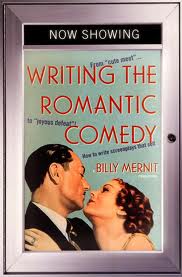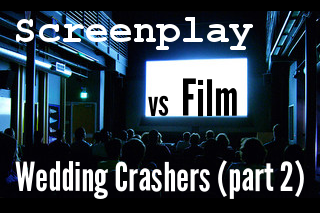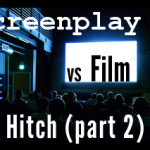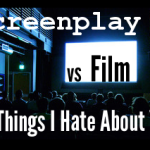Yesterday, I wrote about some of the screenwriting tips I learned by comparing a screenplay draft of Wedding Crashers to the version released in theaters.
Those tips focused mostly on minor changes which, while they enhanced the final product, didn’t greatly alter it. The tweaks discussed today are what, in my opinion, took Wedding Crashers from a laugh-out-loud comedy to box office gold.
They fall into two major categories: deepening “the heart” of the story and refining the ending.
Bill Simmons, the Sports Guy, loved the R-rated antics in the first half of Crashers. But after that, according to him, things went downhill:
Suddenly Wilson was falling in love with McAdams, and they threw in a couple of sappy scenes, and Vince stopped being funny, and we were taking a turn to Chickflickville…
Maybe the last half of the movie isn’t a total lost cause (I did enjoy Ferrell’s inevitable cameo), but after everything that happened in the first hour…
Looking back, this was almost like one of Pedro Martinez’s Red Sox starts in Boston during the past three seasons: Superb until the 100th pitch (when all hell breaks loose). Of course, the key with those Pedro starts was knowing that he needed to come out after 100 pitches, and the key with “Crashers” is knowing that the last 45 minutes pretty much stinks.
Admittedly, the ending of Crashers might’ve been a little heavy on the sweet side, but if you’re attempting to write the next R-rated comedy blockbuster, you have to make absolutely sure that you include genuine emotion along with the raunchy hijinks. Otherwise, the audience will leave the theater feeling dirty and dissatisfied instead of fulfilled.
This doesn’t mean that you sanitize your script. It means that in addition to generating great comedy gags, screenwriters need to mine the relationships between their main characters, searching for something authentic and true.
Although Sherlock Holmes and Back to the Future aren’t R-rated comedies, the deep friendship between the leading characters is something that should be emulated. The “heart” in those movies elevated them into a special cinematic experience.
So how did the Wedding Crashers movie tweak the original screenplay to deepen the film’s “heart” quota? Let’s take a look:
Screenwriting Tip #6: Give the audience a reason to root for the hero
Owen Wilson, who plays John, is a likeable dude. (I’m still puzzled as to why Kate Hudson ever broke up with him.) Naturally, the audience is rooting for John to get the girl.
But as a screenwriter, you should make sure that the audience will root for the hero over the competition for reasons besides casting. You can do this in two ways (preferably a combination of both): you need to show how your hero is perfect for the girl and also why the other guy is unbelievably wrong for her.
The script laid the groundwork for this, portraying John as the redeemed wedding crasher and Sack as the obnoxious trust fund baby. But the movie took that groundwork and deepened it by turning Sack into an intolerable choice for Claire.
For example, in both the movie and the script, Sack manages to plow down Jeremy in what is supposed to be a friendly, lighthearted game of touch football. In the movie, Sack’s prowess is attributed to steroid abuse, setting one black mark against his character.
Later on, when Sack is throwing up in the toilet thanks to the visine snuck into his drinking water, Claire checks up on him. Instead of being grateful for her concern, he’s extremely condescending: “Do you wanna help me out? Do ya? Do ya kid? Why don’t you get me a 7-Up, okay? Because I think I might get vulnerable again.” That’s our second taste of what Claire’s married life with Sack would be like.
The third strike occurs when Sack’s on the phone with one of this friends, bragging about some girl he slept with. If that weren’t bad enough, he also claims that Claire is going to have put aside all her charitable work when she gets married. “I want a wife, not a freaking martyr.”
Furthermore, after Sack bloodies John up at Sack’s engagement party to Claire, the steroid abuser plans on hooking up with one of the female bartenders when the party’s over.
By making Sack so intolerable, the movie made it imperative for Claire to choose John. Now, the audience is invested in seeing John win, and not just because of fortuitous casting.
If you’re writing a movie in which a love triangle plays a part, keep this in mind. (Of course, not all love triangles follow this pattern. Sometimes, a person in the triangle has to choose between two equally perfect options like in This Means War.)
Screenwriting Tip #7: an R-rated comedy is like a sea salt caramel
A sea salt caramel is the perfect combination of sweet and salty. R-rated comedies should be the same. Along with the vulgar humor (the salt), you must include authentic emotion (the sweet).
It’s that balance which gets the audience coming back for second helpings. A lot of writers trying to craft an R-rated comedy will make sure that gross comedy gags abound in their script, forgoing the emotion entirely. This is a big mistake. Make sure you spend equal time on developing both.
For example, in screenwriting tip #2, you already saw that Jeremy spends the night at John’s house on John’s birthday every year. That’s a sappy, but extremely sweet, ritual.
In the middle of the movie, Jeremy wants to get the hell out of Dodge, but John persuades Jeremy to stay using wedding crashing rule #1: never leave a fellow crasher behind. This rather touching moment is in the script as well, but in the movie, it was followed by John and Jeremy exchanging manly, but heartfelt, “I love yous,” showing once again how deep their friendship is.
Even more than his relationship with Jeremy, the movie deepened John’s relationship with Claire. John exchanges two meaningful moments with Claire at her sister’s wedding.
One, when he predicts what’s inside each of the wrapped wedding gifts, and the second, when she abandons her jokey toast and instead says something from the heart, as John had advised.
During Act Two, the movie took these moments and built on them. After John and Jeremy share a crazy dinner with the Cleary family, John and Claire chat outside her home. This scene was in the script, but it was very brief. In the movie, this scene was expanded.
In it, John bonds with Claire by saying that he digs her nutty family, right down to her belligerent grandma, while Claire expresses appreciation for John’s ability to break the ice, especially since her family can be so stuffy. It’s a sweet scene, without one comedy gag or crude joke, making it the perfect follow up to what just transpired between John and “Kitty-Kat.”
Later on, Claire and John go sailing together with her family, and then have a private walk on a secluded beach. In the screenplay version of these scenes, Sack tried to do his best to ruin Claire and John’s burgeoning relationship.
On the Cleary family boat, Sack is too inquisitive:
SACK
You sure you don’t know Skunk? He’s the big guy with Chase up there. Surely in your line, you’ve come across each other.
Sack really doesn’t look well. With each rock of the boat, he gets a little more queasy. John notices this and gets an idea.
JOHN
Hey you know my buddy Dave’s with Chase. I bet he knows him.
(then)
Too bad Dave’s not here. You’d love him. Of course, you’d never catch Dave on a boat again. We went out on a boat one time and you should have seen how sea-sick he got. I’m telling you, it was a mess. We’d all eaten a bunch of lobster rolls and Dave likes his just slathered in mayonnaise. I mean he ate, like, three of them.
Sack is starting to turn green.
JOHN
And a bunch of corn chips. Great guy but he eats like a sea otter.
Sack is trying not to lose his lunch.
JOHN
We’re not out to sea five minutes before this guy blows like Krakatowa. I mean it’s everywhere. It was like reliving the whole lunch.
Sack bolts to the cabin. As he does, he crosses Claire who’s coming back on deck with two beers.
JOHN
Poor guy. He should’ve stayed home.
Next, Sack crashes Claire and John’s visit to a tidal pool:
EXT. MARTHA’S VINEYARD/TIDE POOL – LATER
John and Claire stop their bikes at the edge of a tide pool.
EXT. MARTHA’S VINEYARD – SIMULTANEOUS
Sack pedals furiously on an old bike with a little basket on the front. He looks a lot like the mean lady in the beginning of the Wizard of Oz.
EXT. MARTHA’S VINEYARD/TIDE POOL – LATER
John and Claire exporing the tide pool.
EXT. MARTHA’S VINEYARD – SIMULTANEOUS
Sack is still pedaling like a lunatic. A man walks his dog down the road. Sack rings the old-fashioned bike bell aggressively and nearly runs over the man and his dog.
EXT. MARTHA’S VINEYARD/TIDE POOL – LATER
John picks up a big starfish and tries to put it on Claire’s head. She splashes him. They’re laughing.
Sack pulls up on his bike and watches John and Claire from the hill above the tide pool.
John splashes her back. Soon they are in the midst of a splashing frenzy, getting closer to each other with each splash. They end up in each other’s arms. Claire looks up at John who’s looking back at her intently.
JOHN
So, it would be a total cliché if I kissed you right now, right?
CLAIRE
Yes. A total cliché.
She pulls him in and kisses him.
ANGLE ON: Sack watching them.
Sack pedals away quickly.
If you compare these scenes to the ones in the movie, you’ll notice that in the film, Sack is noticeably absent in both. Why?
After all the preceding comedy gags and raunchy riffs, it was time for the movie to do something unapologetically sweet. Sack’s intrusions diluted the genuine connection being forged between John and Claire with humor.
Learning when to keep the “sweet” parts of your script unadulterated without any hint of a comedy gag, is not a skill you’ll acquire overnight. It takes time…and patience for several revisions as you’ll see in screenwriting tip #8…
Screenwriting Tip #8: Less is more
A lot of funny scenes in the Wedding Crashers screenplay were not in the version released in theaters. These cuts are perplexing, unless you view them through the lens of “less is more,” which is described brilliantly in Billy Mernit’s Writing the Romantic Comedy:

Romantic comedy writers are too often prone to letting dialogue carry their scenes. But the smart ones, like Richard Curtis, know the value of rewriting even one’s choicest lines right out of a scene if it will serve the story best.
Here is what Curtis originally intended for the midpoint of Four Weddings, in the key scene (from the shooting script reprinted in Scenario, vol. 1, no. 1) where Charles and Carrie, having slept together a second time despite her now being engaged to another man, wake up the morning after:
INT. CARRIE’S BEDROOM – DAWN
Dawn coming in Carrie’s bedroom.
CARRIE
I think it’s time you went.
CHARLES
But it’s five in the morning.
CARRIE
And at nine in the morning my future mother-in-law comes round. We’re discussing bridesmaids.
CHARLES
You’re right. I’ve got very little to contribute on that one.
Silently Charles dresses. Watches her. She looks back at him.
CHARLES
You see, this is my whole argument against marriage–even when I’d found the right girl–I’d keep bumping into you.
Her hand comes up and waves him goodbye. He hesitates, and then turns to go.
There’s nothing ostensibly wrong with the scene as written, and a more stubborn writer, enjoying his little joke about bridesmaids and the eloquence of Charles in explaining his feelings, might have argued that the scene was essential.
But Curtis, who wryly admits to seventeen rewrites on Weddings, evidently saw the wisdom of another approach. Here is the scene as published (by St Martin’s Griffin) after the movie was released, reflecting what we all saw on screen:
INT. CARRIE’S BEDROOM – DAWN
Dawn coming into Carrie’s bedroom. Love theme plays. Charles and Carrie lie awake in bed together. Cut to Charles putting on his wedding coat. He watches Carrie, as she lies, half-awake, half-asleep. At her most beautiful. Her eyes open. A long moment. Then quietly he leaves the room.
Screenwriting Tip #9: Intensifying the “all is lost” moment
From the essential plot points every script outline should have, you know how vital the “all is lost” moment is in your script. It’s that scene at the end of Act Two where your hero is farthest away from his goal and seemingly everything he holds dear has been ripped out of his hands.
Think of those wave diagrams from high school physics class (or perhaps you’d like to forget high school physics?). The trough of the wave is the maximum negative, or downward, displacement from the wave’s baseline. Your “all is lost” moment is like that trough, and you want to deepen it as much as possible.
In the script of Wedding Crashers I read, the “all is lost” moment was quite a low point for John. His deceit is exposed by Sack, and it appears that he’s lost Claire for good. He also gets into a fight with Jeremy, blaming him for the end of his blossoming romance with Claire.
Because of their rift, John decides to leave Jeremy’s law firm and relocate to Chicago. In one fell swoop, John loses his love interest and his best friend.
That’s a pretty deep trough.
But it could have been even deeper.
In the movie, John loses Claire, once again because Sack exposes John and Jeremy’s deceit. But the way in which he loses his best friend was completely changed from the way it played out in the script. Dressed up as waiters, John and Jeremy are supposed to crash Claire’s engagement party together.
But Jeremy never arrives.
John is caught by Sack, who badly beats him up. When a bloodied John visits Jeremy to see why his best friend left him in the lurch, he discovers Jeremy hooking up with Gloria, Claire’s sister.
Jeremy betrayed John in the worst way. He not only forgot about his promise to help out John because of a girl, this girl is part of the Cleary family, representing everything John wants but can’t have.
This devastates John, so much so, that he starts to crash weddings himself, and stays in his apartment reading Don’t Jump! Life’s Really Worth It.
With his sleeping bag in tow (nicely set up at the beginning of Act One), Jeremy arrives at John’s for his annual sleepover.
It seems like this friendship is mended, when Jeremy drops a bombshell on John: Jeremy’s getting married to Gloria and he wants John to be his best man.
Although John is happy for his friend, it’s too painful for John to see Jeremy achieve John’s most cherished dream. As John says, “I’m hanging by a thread. I’m reading don’t-kill-myself books.”
In the movie, Jeremy inadvertently twisted a knife deep in John’s back, creating an especially devastating “all is lost” moment.
However your character’s life is broken at the end of Act Two, can you break it even more? You want to be like the Terminator, unstinting in your infliction of pain.
One way to make sure that your audience deeply experiences your protagonist’s loss is to establish early on the value of whatever your hero is losing. In Wedding Crashers, John’s pain was so acute precisely because Jeremy had been such a good friend to him.
The same applies to Annie in Bridesmaids, when the rift between her and her best friend Lillian becomes complete.
To learn how to create a devastating “all is lost” moment for your hero, read this »
Screenwriting tip #10: The seeds of a perfect ending are already in your first draft
In the screenplay draft I read, the ending of Wedding Crashers was radically different than the movie version’s.
John crashed Claire and Sack’s wedding and managed to convince her to say “I’m sorry” instead of “I do” to Sack:
John walks towards the altar. He clears his throat loudly. All eyes turn to him.
JOHN
Excuse me.
SEC. CLEARY
Oh for the love of God!
He motions security over.
SACK
Security!
The Secret Service approach John.
JOHN
Just let me speak my mind and I’ll leave you all alone forever.
Sec. Cleary nods “okay” to the security men.
SACK
(sotto to Claire)
I don’t freaking believe this.
JOHN
Claire, it’s true. I met you because I crashed your sister’s wedding.
(to the guests)
That’s right. I crash weddings. Or at least I used to. In fact…
(pointing to a couple)
I crashed your wedding about a year ago. Very nice, by the way. I will say a vegetarian option is usually a good idea, but otherwise, a wonderful wedding. How’s it going for you by the way?
They nod “pretty good.” From the back of the church, Jeremy clears his throat as if to say, “pick it up.”
JOHN
My point is I’ve changed. I guess I’ve grown up and I don’t know why it took me so long, but well, maybe, it’s because I didn’t see anything worth growing up for and now maybe I do and look, I don’t know…I’m sorry, I’m usually pretty articulate but…I guess it’s a lot harder when you’re not bulls******.
(to the Priest)
Sorry Father.
Father O’Neil nods “don’t worry about it.”
JOHN
Yes, I was a liar. I was a liar because I was scared. But you know what, Claire? You’re scared too. You’re scared to tell the truth about Sack. You’re not in love with that bozo.
Sack turns crimson.
SACK
Okay, I’ve had enough.
He starts to move off the altar. Claire holds his arm.
JOHN
But, Claire, I’ve made a change in my life because of you and maybe you’d like to make a change because of me.
Claire looks at Sack and then looks at John. A long beat and then she smiles at Sack. She leans to him. He smiles. We think she’s going to kiss him. Their lips are about to meet.
CLAIRE
I’m sorry, Sack.
She takes off her veil and steps of the altar. Sack looks at Secretary Cleary as if to say “help me.”
SEC. CLEARY
Claire!
Claire turns around.
SEC. CLEARY
I’m sure you and John will be very happy. At least try to be, okay?
SACK
You’ve got to be kidding!
SEC. CLEARY
Lodge, you’re a tool. In fact, you come from a long line of tools. I suppose you’re maintaining the tool tradition…but not with my daughter.
Sack glares at Sec. Cleary, then bolts off the altar. He’s running straight for John but before he can get there, Jeremy runs up from the back of the church and tackles him.
JEREMY
(to Sack)
Sorry dude, I don’t know what got into me. I’m seeing a Buddhist about it.
Claire runs up and hugs John. They begin rushing out of the church.
JOHN
Thanks, buddy.
JEREMY
My pleasure.
Gloria’s noticed Jeremy for the first time.
GLORIA
Jeremy!
She runs towards him.
This ending is serviceable (although it was stuffed with a lot of head nods).
It neatly resolves all the major story issues. It’s in keeping with the overall comedic and yet sentimental tone of the movie. It would’ve made the audience exiting the theater feel satisfied. Although predictable, it would’ve worked.
The ending of the movie version of Wedding Crashers was all of these things and more. It was brilliant.
First, John decides to pay a visit to Chazz Reinholt, the dude who passed along the rules of wedding crashing to Jeremy. Poor, pathetic Chazz (in a cameo appearance by Will Ferrell) has moved onto crashing funerals. According to him, “grief is nature’s most potent aphrodisiac.” In his state of desperation, John crashes a funeral with Chazz.
When John sees the widow crying at the funeral, he’s deeply affected by this genuine display of emotion, which, he realizes, he will never have in his life if he turns his back on Jeremy or gives up on fighting for Claire.
(In keeping with the sweet and salty tonal blend of the movie, the widow’s honest grief is juxtaposed against Chazz’s highly inappropriate sexual gestures.)
This scene was pure genius. It twisted the sleaziness of wedding crashing into the despicableness of funeral crashing, which was just the kind of dramatic wake-up call John needed to get him back into the game of life. Plus, it created an opportunity for Will Ferrell to make this hilarious cameo appearance.
This scene wasn’t in the script draft I read…although its seeds were.
Remember, one of scenes at the beginning of the screenplay alluded to the mysterious Chazz Reinholt who had crafted the rules of wedding crashing so many years ago.
In the movie, John once again crashes a wedding–but not the union of Claire and Sack, but of Jeremy and Gloria. This is another stroke of brilliance. John’s crashing the wedding of a heretofore confirmed wedding crasher, nicely bringing the movie full circle.
Since Jeremy’s character is portrayed as a hound dog, the audience would never expect his wedding to feature at the movie’s climax, so this ending is also unpredictable (which you want to strive for with your own screenplay endings).
While the climactic scene in the script differed substantially from the movie version, again the seeds for the movie climax were planted in the script.
At the end of the script, after John crashes Claire and Sack’s wedding, we flash-forward to one year later, where Jeremy’s getting married to Gloria.
So this wedding was part of the ending from the beginning, but in successive drafts, its role was expanded until it became the climax, not a grace note.
If you’re struggling with the ending of your screenplay, examine what you’ve already written. Odds are, a brilliant ending, like the one in the movie version of Wedding Crashers is already hinted at in your script.
You just have to isolate those threads, and play several rounds of “what if?” with them until you stumble upon an ending which exceeds your expectations.
Good luck!
Watching a blank screen (with modifications) by Kenneth Lu





















Comments on this entry are closed.
So true! What a great before&after analysis in both posts about this script/film.
Hi Ojo,
I’m glad this analysis helped you! If there is a particular film you’d like to see analyzed on the site, please let me know 🙂